 Often, during our village outreach trips to interview traditional birth attendants about home-delivery practices, we make a stop-over at the local anganwadi centers. Meaning "courtyard shelter" in Hindi, these government sponsored child-care centers serve as day-care & pre-schools for children ages 0-6. As part of the Integrated Child Services program in the mid 1970s, the Indian government developed anganwadi centers in a two-fold effort to: (1) help curb child hunger and malnourishment as well as infant mortality, (2) launch child vaccination programs across the country.
Often, during our village outreach trips to interview traditional birth attendants about home-delivery practices, we make a stop-over at the local anganwadi centers. Meaning "courtyard shelter" in Hindi, these government sponsored child-care centers serve as day-care & pre-schools for children ages 0-6. As part of the Integrated Child Services program in the mid 1970s, the Indian government developed anganwadi centers in a two-fold effort to: (1) help curb child hunger and malnourishment as well as infant mortality, (2) launch child vaccination programs across the country.  Nationwide, an estimated 650,000 anganwadi centers provide child-care services at the village-level including: supplementary nutrition via monthly rations of food, non-formal pre-school education, and vaccinations against Poliomyelitis, TB, Diptheria, Tetanus, Measles, and whooping cough. Off-loading food supplies:
Nationwide, an estimated 650,000 anganwadi centers provide child-care services at the village-level including: supplementary nutrition via monthly rations of food, non-formal pre-school education, and vaccinations against Poliomyelitis, TB, Diptheria, Tetanus, Measles, and whooping cough. Off-loading food supplies:  Each center is run by a local anganwadi teacher and her helper who receive a salary of 1,000 and 700 rupees / month, amounting to approximately 80 cents and 55 cents / day, respectively. These teachers are often well-connected to members of the community, particularly young mothers. Here at our PHRI project, we have an overarching goal of identifying pregnant women in the community to increase uptake of HIV testing and PMTCT services (prevention of mother-to-child transmission of HIV) in both rural and urban settings; to this end, these anganwadi centers serve as an integral link to the rural population.
Each center is run by a local anganwadi teacher and her helper who receive a salary of 1,000 and 700 rupees / month, amounting to approximately 80 cents and 55 cents / day, respectively. These teachers are often well-connected to members of the community, particularly young mothers. Here at our PHRI project, we have an overarching goal of identifying pregnant women in the community to increase uptake of HIV testing and PMTCT services (prevention of mother-to-child transmission of HIV) in both rural and urban settings; to this end, these anganwadi centers serve as an integral link to the rural population.Last week a group of us visited one of Mysore's villages to speak with several mothers in the community. As we walked into the anganwadi center, two kids started crying hysterically, in corporeal fear that strange people = needle prick time. At least the immunization campaign is, indeed, reaching these children. So as we sat, waiting to speak with several mothers, Paul, Purnima and I were faced with making sure the kids warmed up to us. First, we gave out chocolates: who wants chocolate? I do. I do.

Then we started snapping photos and letting the kids look at their faces on our camera screen. Eventually, a few smiles appeared, and soon therafter, some major giggle attacks and a lot of heads smushed together to see the camera. After a makeshift game of duck duck goose and tickle monster (my limited vocabularly in Kanada, I admit, does not include avian species), I had a dedicated crowd of several kids. Somehow this game of counting to 5 ensued... here's a short video clip:
Adorable, these kids are, I know. Eventually, we spoke with some mothers and visited the health center next to the anganwadi center. Many of the women in the community are now delivering their babies at this village center with the help of an auxiliary nurse midwife (ANM). The women deliver here (picture below), bringing and extra set of their clothes to place above the table to soak up the blood during childbirth.









 So 11 high school boys and I played volleyball for a good two hours, six on six in the dirt. They were pretty good, I was impressed.
So 11 high school boys and I played volleyball for a good two hours, six on six in the dirt. They were pretty good, I was impressed.




 I left the market and continued exploring. Ate some delicious pomegranate and enjoyed India.
I left the market and continued exploring. Ate some delicious pomegranate and enjoyed India.







 A peaceful beginning to each day.
A peaceful beginning to each day.